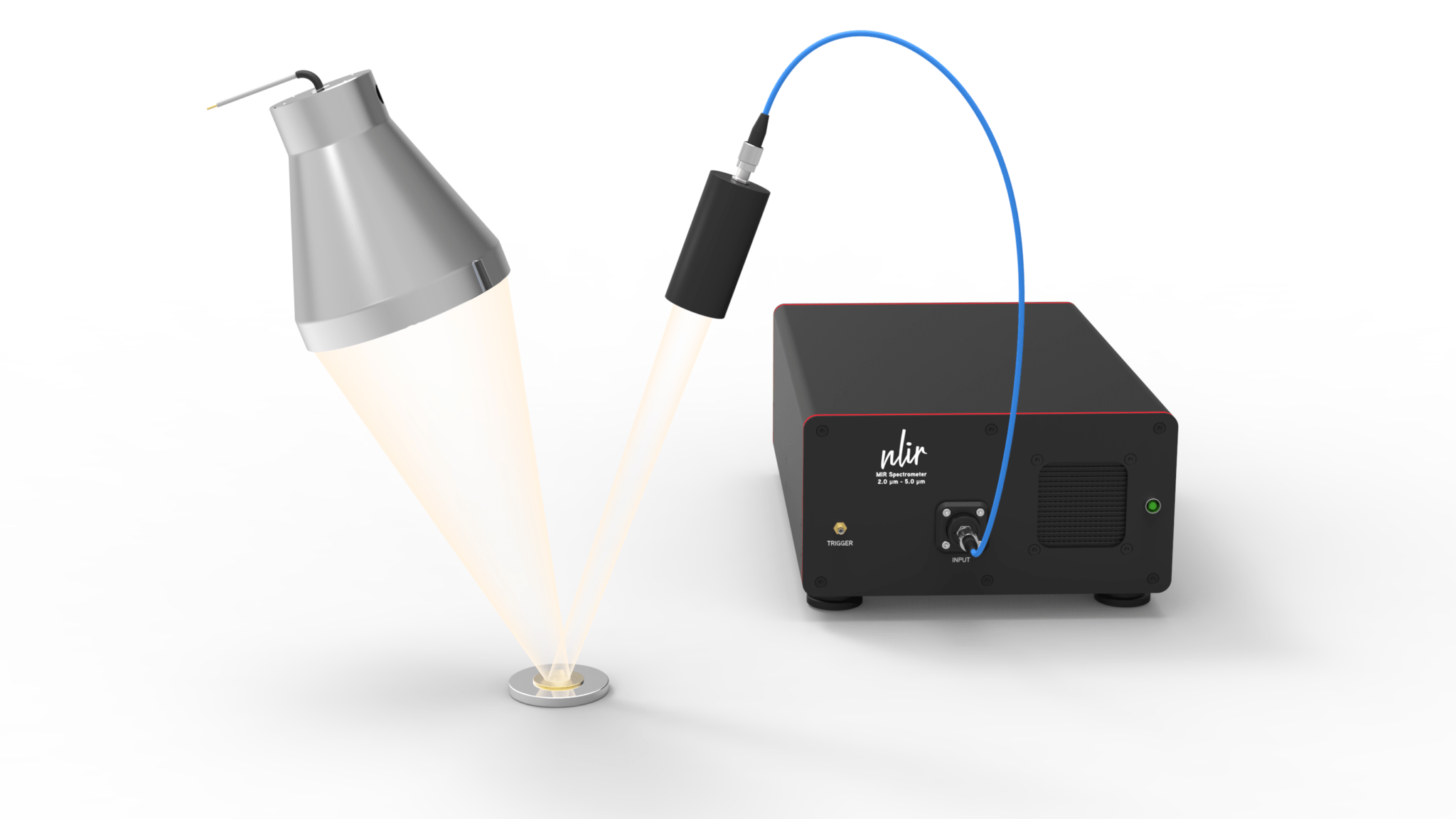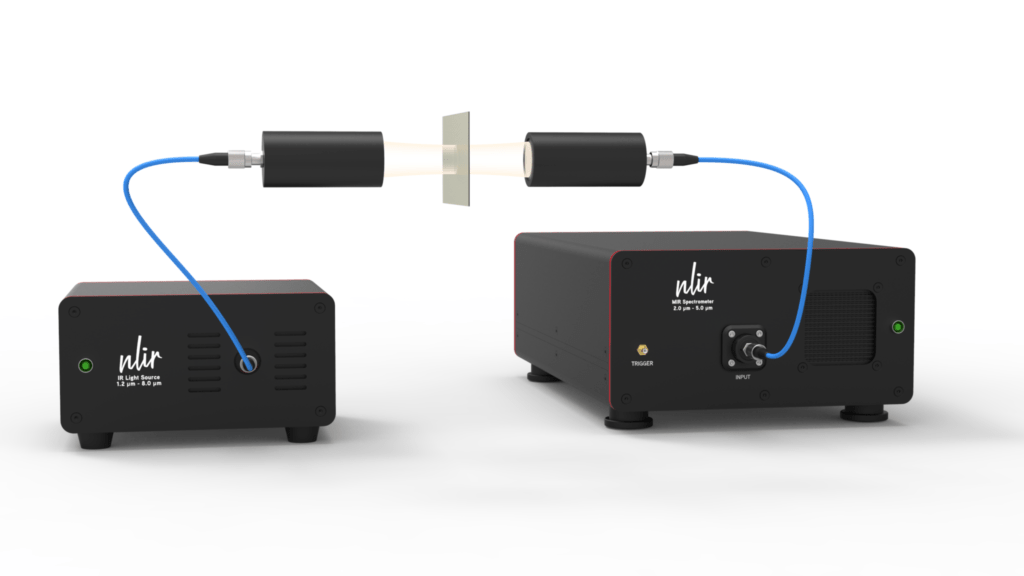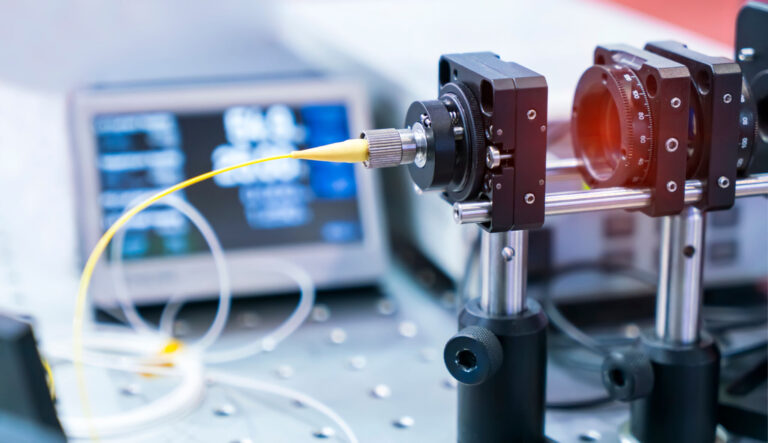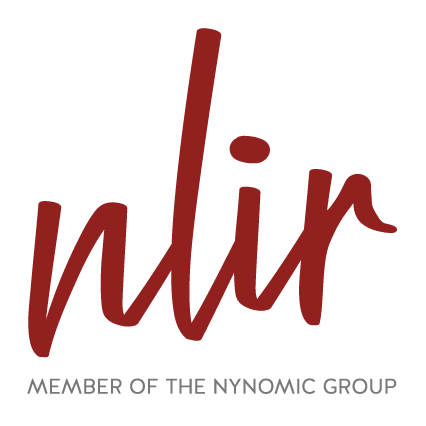Measurement bundles
The most time-consuming task often is to set up the optical interface to the sample. Therefore, NLIR has developed a series of measurement bundles to ease the task. Each bundle comes with NLIR’s MIR spectrometer, MIR light source, software, and fibers for you to simply plug in the devices and perform the desired measurements.
There’s no general optimal interface for spectroscopic measurements – different samples require different interfaces. However, NLIR has made several different custom solutions and many measurement tests for a wide range of applications in the industry. The best and most frequently used bundles have converged into the products shown below.
Fiber-coupled probe bundle
For small samples, NLIR has developed a fiber-coupled probe that measures in a small and well-defined area. The light is brought from the NLIR light source by fiber to the sample and collected again by fiber and brought to the NLIR spectrometer. This results in a fast and sensitive probing setup.
The probing area can be as small as a few hundred micrometer and only that area is measured. The light that returns to the spectrometer has detailed information about the infrared properties of the sample. A typical measurement time with this setup is 100 ms.
Do you want to know more about measurement bundles or get a price? Contact us today!

Benefits:
- Fiber to and from sample
- Small measurement area
- Good for small or integrated devices

Benefits:
- Powerful light source
- Light collecting optics
- 1 cm measurement area size
- Good for plastics, non-transmissive materials, and surface samples
Reflection bundle
Measurements done in reflection from a given sample needs a powerful light source and a means to get the reflected light to the spectrometer.
NLIR has designed an elliptical reflector optimized to be positioned 20 cm from the sample and illuminate and area of approx. 1 cm diameter. Reflected light is collected by the fiber head and sent to the spectrometer.
Different samples can be investigated in this setup, for example, black plastics, coated metal plates, or reflective optics. As an example, read about the efficient plastic sorting project here.
Do you want to know more about measurement bundles or get a price? Contact us today!
Fiber-coupled transmission bundle
Thin, semi-transparent samples are ideal for transmission spectroscopy. As long as the sample is not too absorptive, transmission is an easy and efficient way of measuring its infrared properties.
With NLIR’s fiber-coupled transmission bundle, it is very easy to start measuring the infrared properties of films, foils, coatings, and even liquids in thin flow cells. The fibers make it easy to mechanically decouple the light source and spectrometer from the sample.
Do you want to know more about measurement bundles or get a price? Contact us today!

Benefits:
- Fiber to and from sample
- Easy setup and measurement
- Good for thin and semi-transparent samples
More on optical interfaces
The key to an optical characterization setup is to ensure that infrared light interacts with the sample in a way that brings the most amount of light with the most amount of information to the detector. For example, a metallic mirror reflects a lot of light so as a sample it gives a high signal but little information about the mirror substrate because the light never enters beyond the front surface of the mirror. On the other hand, a piece of black plastic measured in transmission will give insufficient light for the detector, however a small amount of light that makes it through carries a lot of information about the plastic.
A few more examples of different samples and how to overcome their challenges:
- Coated steel plates: Steel coils or plates are often highly reflective, so a coating is easily measured in reflection with both significant signal and lots of information. The challenge for this sample is that it is most often large so measurements most be done fast to cover the largest possible area in a given time. A powerful light source and fast spectrometer is needed to perform this task.
- Plastic films/foils: Transmission gives both high signal and lots of information. If the foil becomes too thick, typically more than 1 mm, insufficient light for a spectrometer is likely to be a problem.
- Black (waste) plastic: This sample is usually too thick for transmission and must be measured in reflection. Reflection measurements are often very sensitive to the surface roughness and the amount of reflected light can vary significantly. However, the reflected light holds a lot of information. A powerful light source and a fast and sensitive spectrometer is needed for this application.
- Silicon wafers/integrated devices: Many components on integrated devices either have infrared properties or can be characterized by infrared radiation. Important for this kind of sample is that only a comparatively small area is measured. Optical fibers are very useful to bring light to and from a small sample and onward to a spectrometer. NLIR has developed a fiber coupled probe for exactly this purpose.
- Liquids: Far most measurement situations with liquids somehow involve water, which strongly absorbs infrared light. Therefore, the most common technique for ensuring both plenty of signal and a lot of information is using an attenuated total reflectance (ATR) crystal in which the light is brought in contact with the liquid at the crystal-liquid interface from inside the crystal.
- Powder: Measuring the infrared properties of a sample in powder form is notoriously difficult because light is scattering upon interaction. There’s no standardized way of performing this task but NLIR has had some success with measurements in reflection. Low amount of light is returned from a powder sample so the highest possible sensitivity in the detector is needed.
Looking for an expert to help you with your project measurements?
Reach out to our experts for solutions to your measurement challenges.

